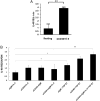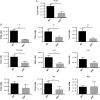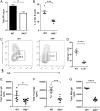Identification of IL-40, a Novel B Cell-Associated Cytokine
- PMID: 28978694
- PMCID: PMC5667921
- DOI: 10.4049/jimmunol.1700534
Identification of IL-40, a Novel B Cell-Associated Cytokine
Abstract
We describe a novel B cell-associated cytokine, encoded by an uncharacterized gene (C17orf99; chromosome 17 open reading frame 99), that is expressed in bone marrow and fetal liver and whose expression is also induced in peripheral B cells upon activation. C17orf99 is only present in mammalian genomes, and it encodes a small (∼27-kDa) secreted protein unrelated to other cytokine families, suggesting a function in mammalian immune responses. Accordingly, C17orf99 expression is induced in the mammary gland upon the onset of lactation, and a C17orf99-/- mouse exhibits reduced levels of IgA in the serum, gut, feces, and lactating mammary gland. C17orf99-/- mice have smaller and fewer Peyer's patches and lower numbers of IgA-secreting cells. The microbiome of C17orf99-/- mice exhibits altered composition, likely a consequence of the reduced levels of IgA in the gut. Although naive B cells can express C17orf99 upon activation, their production increases following culture with various cytokines, including IL-4 and TGF-β1, suggesting that differentiation can result in the expansion of C17orf99-producing B cells during some immune responses. Taken together, these observations indicate that C17orf99 encodes a novel B cell-associated cytokine, which we have called IL-40, that plays an important role in humoral immune responses and may also play a role in B cell development. Importantly, IL-40 is also expressed by human activated B cells and by several human B cell lymphomas. The latter observations suggest that it may play a role in the pathogenesis of certain human diseases.
Copyright © 2017 by The American Association of Immunologists, Inc.
Conflict of interest statement
Disclosures
V.P.L., P.A.H., A.M.B., I.U., and A.Z. are inventors named in a patent application (U.S. Provisional Patent Application number 61/906,855) describing uses of IL40 filed by the Regents of the University of California. The other authors have no financial conflicts of interest.
Figures








References
-
- Lunney JK. Cytokines orchestrating the immune response. Rev - Off Int Epizoot. 1998;17:84–94. - PubMed
-
- Clavel G, Thiolat A, Boissier MC. Interleukin newcomers creating new numbers in rheumatology: IL-34 to IL-38. Joint Bone Spine. 2013;80:449–453. - PubMed
-
- Lee J, Hever A, Willhite D, Zlotnik A, Hevezi P. Effects of RNA degradation on gene expression analysis of human postmortem tissues. FASEB J. 2005;19:1356–1358. - PubMed
-
- Roth RB, Hevezi P, Lee J, Willhite D, Lechner SM, Foster AC, Zlotnik A. Gene expression analyses reveal molecular relationships among 20 regions of the human CNS. Neurogenetics. 2006;7:67–80. - PubMed
Publication types
MeSH terms
Substances
Grants and funding
LinkOut - more resources
Full Text Sources
Other Literature Sources
Molecular Biology Databases
Miscellaneous

